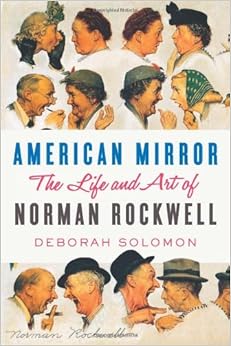Norman Rockwell always referred to himself as an illustrator, not an artist. He wanted to be an artist, but he didn't think he was good enough. For most of his long career, the art world felt the same way. He lived at a time when Jackson Pollock and other abstract artists dominated the scene. Rockwell, besides being considered old-fashioned, was too popular and simply made too much money to be taken seriously by the art elite.
Yet Deborah Solomon's excellent 2014 Rockwell biography has a telling title: American Mirror: The Life and Art of Norman Rockwell. To this professional art critic, also a biographer of Pollock, he was indeed an artist, and her book gives him his due as such.
The change in how Rockwell was viewed began late in his life, encouraged by, of all things, the Pop art movement of Andy Warhol and others. If a realistic painting of a soup can can be seen as a work of art, then surely Rockwell's brand of realism qualifies as well. And Rockwell, as Solomon points out, was a much better painter than Warhol. She writes, "Warhol used the techniques of commercial art to make high art, whereas Rockwell used the techniques of high art to make commercial art."
Solomon critiques each of Rockwell's major paintings, telling us how it came to be, who posed for it and how it stands up as a work of art. She does this without downplaying the main objective of a biographer's job, telling a life story. For someone who spent most of his time in his studio painting pictures, Rockwell led an interesting life. He had three wives, met many famous people and traveled a great deal. While his paintings were often considered, rightly or wrongly, a reflection of America's past, some of them, especially his painting of Ruby Bridges, the little black girl in the white dress being escorted to school by federal marshals, helped shape its future. He was, for someone so quiet and unassuming, very influential.
Where Solomon fails her subject is in her attempts to psychoanalyze him, trying to read things into his life and into his paintings that may or may not be there. She says repeatedly that "there is no evidence to suggest that he behaved in a way that was inappropriate" toward the boys who posed for him, yet that doesn't stop her from suggesting that he, at the very least, had inappropriate thoughts. She finds something sexually suggestive about the painting The Runaway showing, from behind, a cop and a runaway boy sitting on restaurant stools. Rockwell did paint many pictures of boys, in part because of his Boy Scout calendars, but he also painted many girls, as well as men and women. If he didn't paint sexy women, perhaps his own explanation, that he simply couldn't do it very well, was the truth. Solomon's most ridiculous comment may be when she says Rockwell "squeezed his feet into tight shoes, as if trying to keep the dirtier parts of himself constrained." Or maybe he was vain about big feet or simply preferred tight shoes.
Solomon insists the busy artist devoted too little time to his wives, but she says his second wife, Mary, twice read War and Peace aloud to him. How much time would that have taken?
The man had plenty of faults and plenty of insecurities and compulsions, but his biographer does him a disservice by finding shortcomings that may only be in her imagination.

No comments:
Post a Comment